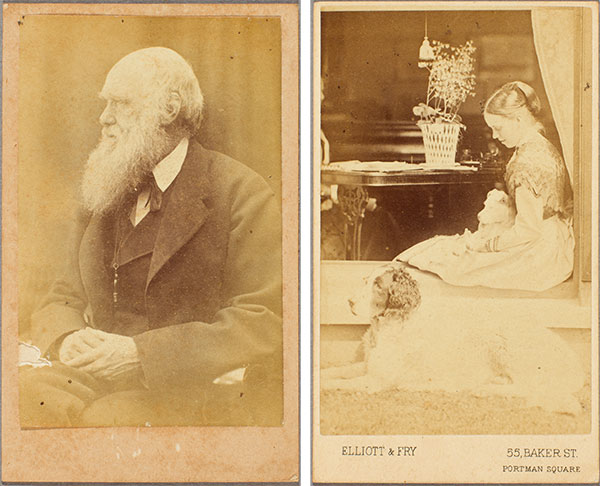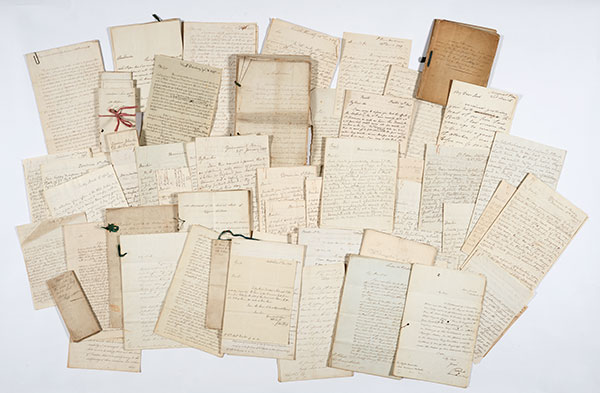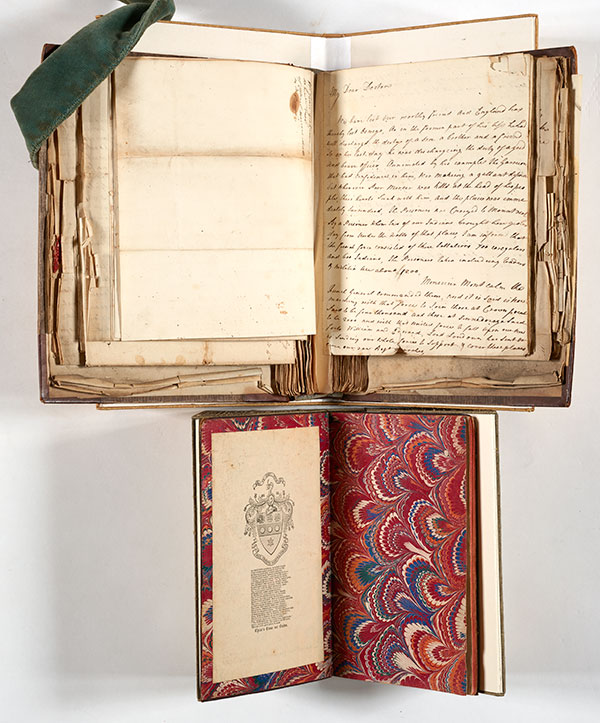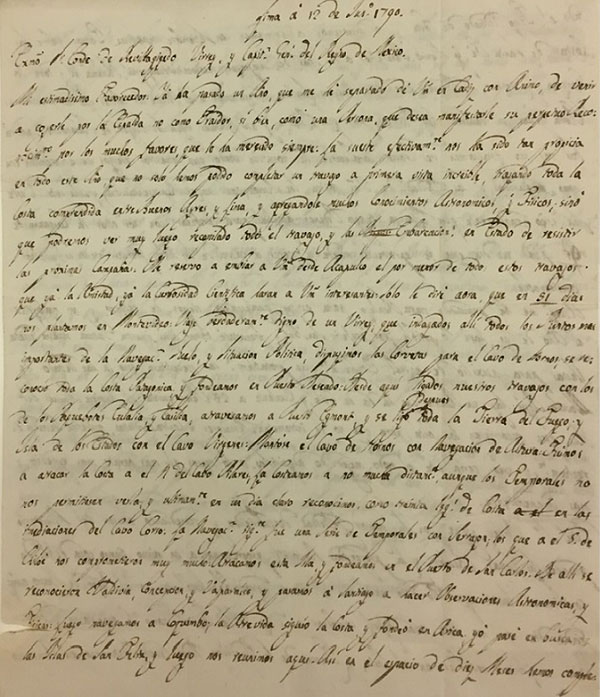News Release - The Huntington Acquires Unique Darwin Photo Album
Posted on Tue., Feb. 6, 2018
Library Collectors' Council also purchases manuscript collections of an 18th- and 19th-century British politician and bureaucrat, and of a British officer killed during the Battle of Fort Oswego, as well as a letter reporting on a 1790 Spanish scientific expedition to the Americas and the Pacific.

Charles Darwin (left) and his daughter Henrietta Emma "Etty" Litchfield. Carte-de-visite Photograph Album (Down, Kent, 1871-1879), 19 albumen prints (2 1/2 x 3 1/2 in.). The Huntington Library, Art Collections, and Botanical Gardens.
SAN MARINO, Calif.—The Huntington Library, Art Collections, and Botanical Gardens announced today that it has acquired a unique photograph album, containing 19 prints, that offers a tantalizing glimpse into the intimate family circle of renowned scientist Charles Darwin (1809-1882). Inscribed to a member of Darwin's circle about whom nothing is known, and depicting several unpublished images of sitters ranging from close family members to those not yet identified, the rarity was purchased at The Huntington's 21st annual Library Collectors' Council meeting held earlier this month.
The Council also purchased manuscript collections of Henry Dundas, 1st Viscount Melville (1742-1811), the United Kingdom's Home Secretary, Secretary of War, and First Lord of the Admiralty, and of James Francis Mercer (d. 1756), a British officer killed during the Seven Years' War while commanding Fort Oswego in New York.
In addition, The Huntington acquired a letter by Italian explorer and Spanish naval officer Alejandro Malaspina (1754-1810), reporting to the viceroy of New Spain in 1790 on a scientific expedition he co-commanded to the Americas and the Pacific. The Library Collectors' Council is a group of 46 families who assist in the development of the collections by supporting the purchase of important works that the Library would not otherwise be able to afford.
"This year's acquisitions extend and enhance our existing collections in history, the history of science, and photography," said Sandra Brooke, Avery Director of the Library at The Huntington. "Such materials have the potential to open new and unexpected pathways for research in these fields. We are deeply grateful to the Collectors' Council for its vision and exceptional support."
Highlights of the newly purchased materials:
A Darwin Family Photograph Album
This unique carte-de-visite photograph album of 19 albumen prints offers a tantalizing glimpse into the intimate family circle of Charles Darwin, the English scientist best known for his work on the theory of evolution. Victorian photographic albums were cherished artifacts in middle- to upper-class homes, serving as keepsakes to memorialize family and friends. This one offers scholars new insight into the complex web of interpersonal relationships surrounding Darwin. "While we know some of the individuals in the pictures, including Darwin himself, of course, there are others that we have yet to identify," said Jennifer Watts, The Huntington's curator of photography and visual culture. "This is, in a very straightforward way, a researcher's dream."
Similar in size to a prayer book, this album of portraits has the look and feel of a devotional tome, Watts added. "Its sacramental appearance runs counter to our contemporary view of Darwin as pronouncer and arbiter of evolution. At a time in which family bonds proved indispensable—both as social networks and as a means of labor—this album is an object at the intersection of science and sentimentality."
Several of the 10 Darwin offspring were deeply involved in their father's work; six are represented in the album. Some of the images are studio portraits by such notable photographers as Oscar G. Rejlander, who collaborated with Darwin on his The Expression of the Emotions in Man and Animals (1872). Other pictures are intimate (and unpublished) tableaus: an unknown baby on the lap of a Darwin son; a Darwin daughter in a windowsill with her two dogs. Also included are pictures of Darwin, his wife, Emma, and children George Howard; Horace (a scientist and the youngest of the Darwin children to survive into adulthood); Elizabeth ("Bessy"); and Henrietta Emma ("Etty") Litchfield.
Henrietta was a valued companion to her father, an editor of his work, and a correspondent with both of her parents. She was a linchpin in the Darwin circle, helping to anchor the scientific and domestic activities of her family. Henrietta's husband, Richard Buckley Litchfield, inscribed the album to a woman named Anne Griffiths in 1879.
The album's many mysteries invite scholarly scrutiny. Nothing is known of Anne Griffiths or the Darwin family's relationship to her. Several unpublished images depict as yet unidentified sitters—none of them known to be blood relatives—who, once identified, will prove crucial in extending our understanding of Darwin's inner circle.
In 1993, The Huntington acquired one of the greatest collections of Darwiniana ever assembled: the Warren D. Mohr collection of 1,600 books, caricatures, engravings, and photographs.
"In one fell swoop, the acquisition of the Mohr collection made The Huntington an international hub for scholars interested in the life and legacy of Charles Darwin," said Daniel Lewis, Dibner Senior Curator of the History of Science and Technology at The Huntington. "Adding this extraordinary photograph album to our Darwin holdings invites the scholarly world to help us puzzle out the evolution of this great scientist's human ties."
Archive of Henry Dundas, Home Secretary, Secretary of War, and the First Lord of the Admiralty

Archive of Henry Dundas, Viscount Melville, Home Secretary, Secretary of War, and First Lord of the Admiralty. Collection of approximately 126 manuscript items (nearly 1,000 pages), compiled by the Dundas family. The Huntington Library, Art Collections, and Botanical Gardens.
This collection contains roughly nearly 1,000 pages of manuscript letters and documents sent mostly to the Scottish politician Henry Dundas, 1st Viscount Melville (1742-1811), and some to his son Robert, 2nd Viscount Melville (1771-1851), who served as President of the Board of Control for India and First Lord of the Admiralty. The collection principally focuses on British possessions in India, the East Indies, and the West Indies; relations with the United States; and hostilities, negotiations, and political maneuvers with other European powers, especially France and Russia.
In the late 18th and 19th centuries, the British were determined to expand their empire and defeat the French in the process. This involved aggressive military offensive maneuvers and required delicate diplomatic negotiations in the Middle and Far East. During the French Revolution and slave rebellion in French-controlled islands in the West Indies, the British also relied on instability within French territories to tip the balance of power in their favor. The British were active and passive players in what they called "The Great Game."
"Some of the pieces in this collection are marked 'Private' and 'Confidential'—none of this material is known to have been seen by scholars," said Vanessa Wilkie, William A. Moffett Curator of Medieval Manuscripts and British History at The Huntington. "The collection is of enormous research value and perfectly fits within The Huntington's internationally renowned holdings of 18th- and 19th-century British historical manuscripts, with specific areas of strength in the British navy, admiralty, maritime history, East India Company, Atlantic World, slavery, and early North American collections."
This is not The Huntington's first acquisition related to the Dundas family. In 1923, Henry E. Huntington acquired 42 items from the Dundas Papers pertaining to the War of 1812. In 2014, the Library Collectors' Council purchased the Harford Jones Collection. "At the time of both of those acquisitions," said Wilkie, "no one knew that all of these manuscripts were actually part of a larger collection. Acquiring the Henry Dundas Papers reunites all of this material and places a bulk of Dundas Papers in our repository."
The collection dovetails with numerous items in The Huntington's collections that attract researchers, including rare books pertaining to Henry Dundas's impeachment trials from the Admiralty; hundreds of letters found in the five volumes of the Richard Colley Wesley, Marquis Wellesley letterbooks, 1809-1811; hundreds of rare books and maps pertaining to the Atlantic World in the 18th and 19th centuries; and tens of thousands of related materials pertaining to the Napoleonic Wars, slavery, slave rebellions, the navy, the admiralty, the East India Company, and British parliamentary politics.
Letters of James Francis Mercer, a British Officer in America

John F. Mercer collection of 126 letters, manuscripts, and documents, bound in three-quarter calf and paper-covered boards by "Seton Bookbinder Edinburgh" (Robert Seton III, 1844-1905); includes a copy of Papers Relating to the First Settlement and Capture of Fort Oswego, 1727-1756 (Albany: Weed, Parsons & Co., 1849), with Mercer escutcheon pasted on the front inner cover. The Huntington Library, Art Collections, and Botanical Gardens.
In 1756, James F. Mercer, who had sailed to America a year earlier, was put in command of the poorly designed and dilapidated Fort Oswego in New York, located "in the back of God's elbow," as he put it. On Aug. 11, he dispatched a scouting expedition that discovered a 3,000-strong French and Indian force. The next day, the commander of the French army, Louis-Joseph de Montcalm-Gozon, Marquis de Saint-Veran informed Mercer that the fort was under siege.
On Aug. 14, at about 7 a.m., as Montcalm's forces began their attack, Mercer was the first Oswego defender to be killed, beheaded by a French cannonball. His grisly death so unnerved his next in command that he immediately sent a flag of truce. In the chaos that ensued, the members of the garrison who had surrendered were in turn attacked by Native Americans who were French allies.
Until the discovery of this collection, very little was known about Mercer—by all accounts, a capable commander and courageous officer. The only information available came from a handful of military records, including those found in The Huntington's collection of the papers of John Campbell, the 4th Earl of Loudoun, the commander-in-chief of all British armed forces during the Seven Years' War at the time of Mercer's death.
"The candid, expressive, richly detailed, witty, and moving letters in this remarkable collection of 126 items cover Mercer's tour of Flanders in 1735, his service in the West Indies, his life in Perth and London, and his fateful American tour," said Olga Tsapina, Norris Foundation Curator of American History at The Huntington.
The collection also contains a detailed account of the fall of Fort Oswego put together by James Grahame, Mercer's grieving friend, at the time when the debacle was the subject of much hand-wringing. For his narrative of the Oswego disaster, Grahame incorporated Mercer's own letters to him and interviewed survivors. The collection also includes documents on the settling of Mercer's accounts with the British army.
"This extraordinary find perfectly complements The Huntington's famous Seven Years' War collections," said Tsapina. "The trove of letters not only sheds new light on the tragic story of the fall of Oswego, but also provides researchers of military, political, social, and cultural aspects of 18th-century Scottish, British, American, and transatlantic history with new, untapped sources."
Letter from Alejandro Malaspina to the Viceroy of New Spain

Autograph letter, signed, from Alejandro Malaspina to the Viceroy of New Spain, on the progress of the Malaspina Expedition (Lima, June 12, 1790), three pages quarto, on a folded folio sheet. The Huntington Library, Art Collections, and Botanical Gardens.
This unpublished letter (dated June 12, 1790) by Alejandro Malaspina (1754-1810) to the Conde de Revillagigedo, the viceroy of New Spain, offers a fresh source on the most important Spanish scientific voyage of the 18th century. An Italian aristocrat and commander in the royal Spanish navy, Malaspina received permission from the Spanish king, Charles III, for a scientific expedition to the Americas and to the Pacific. Malaspina modeled the expedition on, and designed it to surpass, the voyages of the British naval hero James Cooke and the French explorer the Comte de La Pérouse.
Malaspina and his co-commander, José de Bustamante y Guerra, were charged with conducting scientific investigations and reporting on the state of Spain's overseas colonies. Setting sail in two ships from Cadiz in 1789, the expedition explored the coasts of Spanish South America and the western coast of North America, including that of Alaska. The latter involved a search for the Northwest Passage (which the expedition confirmed did not exist). The expedition then sailed to the Pacific before returning to South America and reaching Cadiz again, in 1794. In total, the expedition gathered more than 10,000 specimens of flora and fauna, many of them unknown to Europeans—a rousing scientific success. Moreover, the expedition's reports on indigenous peoples remain important ethnographical sources. Malaspina and his staff created, for the first time, accurate cartographical and hydrographical charts of sections of the coasts of South America and the western coast of North America.
After returning to Spain, Malaspina became involved in court intrigue, and the Spanish Crown consequently suppressed his work as punishment. A few of the expedition's findings came out, but Malaspina never received credit for them.
With a provenance traceable to the Conde de Revillagigedo's family, the letter provides detailed information on one of the great scientific voyages of the Age of Enlightenment. It is a prime historical source that supports The Huntington's rich collections on Spanish exploration and travel in the Americas and, overall, its Spanish colonial collections.
Malaspina's letter extends The Huntington's important collections on Spanish colonial exploration in the Pacific, which include López de Haro's 1788 logbook for his voyage to Alaska, the Pedro de Alberni voyages of 1789-1792, and the Bodega de Cuadra diary of a 1792 voyage along the western coast of North America.